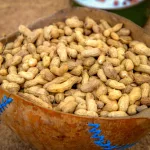Nigerian cocoa refers to cocoa beans or cocoa products that originate from Nigeria. Cocoa is the primary ingredient in chocolate production and is obtained from the cacao tree’s beans. Nigerian cocoa is known for its unique flavor profile, which is influenced by the country’s climate, soil, and agricultural practices.
In Nigeria, cocoa is a significant agricultural commodity and plays a vital role in the country’s economy. Nigerian cocoa beans are primarily grown in the southwestern and southeastern regions of the country. The most well-known cocoa-producing states in Nigeria include Ondo, Osun, Cross River, and Ekiti.
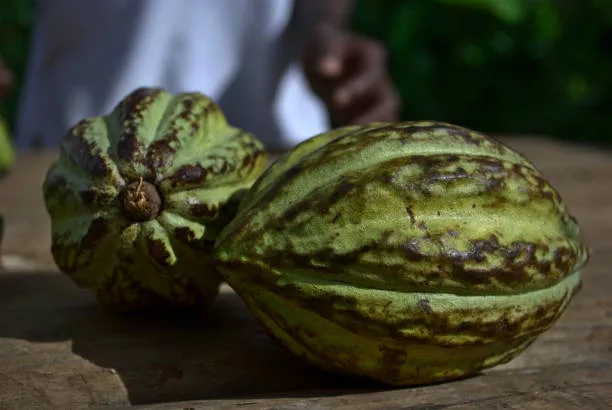
The flavor of Nigerian cocoa is often described as rich, with fruity and earthy undertones. This distinct flavor is attributed to the unique terroir, which includes the local climate, rainfall patterns, and soil characteristics. The cacao beans from Nigeria are typically Forastero varieties, which are known for their robust and full-bodied chocolate flavor.
Nigerian cocoa is a valuable export commodity, and the country is one of the top cocoa-producing nations in Africa. The cocoa industry in Nigeria provides employment opportunities for many people, from small-scale farmers to workers in processing and exportation.
The cocoa sector in Nigeria faces challenges such as low productivity, aging cocoa trees, and the need for modernization. However, efforts are ongoing to improve cocoa farming practices, increase yield, and ensure the sustainability of the industry.
Nigerian cocoa is a vital ingredient in the global chocolate supply chain, and its unique flavor makes it a sought-after component for chocolate makers worldwide. So, whether you enjoy a bar of chocolate or a cup of hot cocoa, there’s a chance it might contain some of the delicious cocoa produced in Nigeria!
Comparative Analysis of Nigerian Cocoa
let’s take a closer look at a comparative analysis of Nigerian cocoa. Nigerian cocoa, like cocoa from other countries, has its own unique characteristics, advantages, and challenges. Here’s a breakdown of some key points in this comparison.

1. Flavor Profile:
- Nigerian Cocoa: Nigerian cocoa is renowned for its unique and robust flavor, with fruity and earthy undertones. It’s often described as having a rich and full-bodied taste. This flavor is influenced by Nigeria’s climate, soil, and agricultural practices.
- Global Cocoa: Cocoa is grown in various regions around the world, and the flavor profiles can vary significantly. For instance, cocoa from West African countries like Ivory Coast and Ghana is known for its mild and slightly nutty flavor, while cocoa from Latin American countries like Ecuador is recognized for its floral and nutty notes. Each region’s cocoa has distinct characteristics.
2. Cocoa Varieties:
- Nigerian Cocoa: Nigeria primarily cultivates Forastero cocoa varieties, which are known for their resistance to diseases and high cocoa bean yield. This variety is the most commonly grown in Nigeria.
- Global Cocoa: Worldwide, cocoa is broadly categorized into three main varieties: Criollo, Forastero, and Trinitario. Different regions may favor one variety over others based on factors such as climate and disease resistance.
3. Production Volume:
- Nigerian Cocoa: Nigeria is one of the top cocoa-producing countries in Africa and globally. It consistently ranks among the world’s top cocoa producers, with an annual production of cocoa beans.
- Global Cocoa: Globally, Ivory Coast and Ghana are the two largest cocoa-producing countries, with a significant share of the world’s cocoa production. They are followed by countries like Indonesia, Nigeria, and Cameroon, among others.
4. Challenges:
- Nigerian Cocoa: The Nigerian cocoa industry faces challenges such as aging cocoa trees, low productivity, and issues related to infrastructure and quality control. Modernization and rejuvenation of cocoa farms are ongoing efforts.
- Global Cocoa: Cocoa-producing regions worldwide face challenges related to pests and diseases, environmental sustainability, fair labor practices, and fluctuating cocoa prices on the global market.
5. Economic Impact:
- Nigerian Cocoa: Cocoa is a vital part of Nigeria’s economy, providing employment opportunities for millions of people, from farmers to workers in cocoa processing and exportation.
- Global Cocoa: Cocoa plays a crucial role in the economies of many cocoa-producing countries. It is a source of income and livelihood for numerous smallholder farmers and contributes significantly to their GDP.
Nigerian cocoa offers a unique and distinct flavor profile that sets it apart from cocoa produced in other regions. However, it also faces its own set of challenges, including the need for modernization and improved farming practices. The global cocoa industry, on the other hand, is a complex and interconnected network of cocoa-producing countries, each contributing to the world’s chocolate supply in its own way.
Nutritional Properties of Nigerian Cocoa
Nigerian cocoa, like cocoa from other regions, has a range of nutritional properties. Here’s a look at some of the key nutritional components of Nigerian cocoa:

1. Calories:
Cocoa is a calorie-dense food. One ounce (28 grams) of unsweetened cocoa powder contains approximately 12 calories. However, the calorie content can vary depending on the type of cocoa product and any added ingredients, such as sugar and milk.
2. Macronutrients:
- Protein: Cocoa contains a modest amount of protein, roughly 1-2 grams per ounce of cocoa powder.
- Fat: Cocoa is naturally low in fat, with approximately 1-2 grams of fat per ounce. The fat in cocoa is primarily composed of healthy monounsaturated and saturated fats.
3. Fiber:
Cocoa is a good source of dietary fiber, with around 3-4 grams of fiber per ounce. Fiber is essential for digestive health and can help regulate blood sugar levels.
4. Minerals:
- Iron: Cocoa is a decent source of iron, providing about 10% of the recommended daily intake per ounce. Iron is crucial for red blood cell production and oxygen transport in the body.
- Magnesium: Nigerian cocoa is rich in magnesium, offering approximately 15-20% of the daily recommended intake per ounce. Magnesium is essential for muscle and nerve function, bone health, and energy production.
- Potassium: Cocoa also contains potassium, which helps regulate blood pressure and fluid balance in the body.
5. Antioxidants:
- Flavonoids: Cocoa is a rich source of flavonoids, particularly flavanols. These powerful antioxidants are associated with various health benefits, including improved heart health and cognitive function.
- Theobromine: This natural compound found in cocoa acts as a mild stimulant and vasodilator. It’s what gives cocoa its stimulating effect and is related to caffeine, though theobromine is milder.
6. Health Benefits:
- Heart Health: The antioxidants in cocoa may help improve heart health by reducing the risk of heart disease, improving blood flow, and lowering blood pressure.
- Mood and Cognitive Benefits: Cocoa may have mood-enhancing and cognitive benefits, thanks to its theobromine content.
- Antioxidant Properties: The flavonoids in cocoa are known for their powerful antioxidant properties, which can protect cells from oxidative damage.
It’s important to note that the nutritional properties of cocoa can vary based on the processing method and the addition of other ingredients in cocoa products. For example, dark chocolate with a high cocoa content will contain more of these beneficial nutrients compared to milk chocolate, which has added milk solids and sugars.
In moderation, consuming cocoa or cocoa-rich products can be a part of a healthy diet and may offer several health benefits. However, it’s crucial to be mindful of added sugars and excessive calorie intake when enjoying cocoa-based treats.
Health Benefits of Nigerian Cocoa
Nigerian cocoa, like cocoa from other regions, offers several health benefits when consumed in moderation. Here are some of the potential health benefits of Nigerian cocoa:
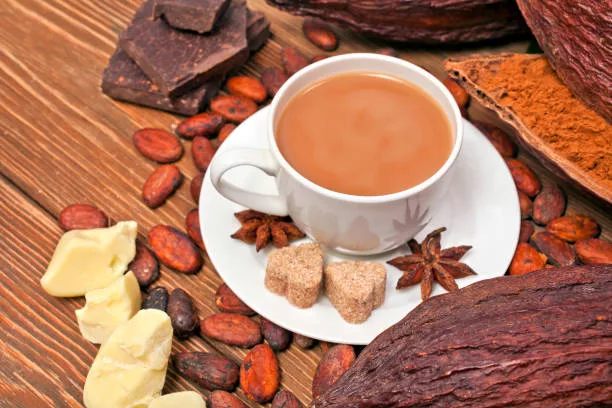
1. Antioxidant Power:
- Nigerian cocoa is rich in flavonoids, particularly flavanols. These powerful antioxidants can help protect your cells from oxidative damage caused by free radicals. This, in turn, may lower the risk of chronic diseases, including heart disease and certain types of cancer.
2. Heart Health:
- The flavanols in cocoa can have a positive impact on heart health. They may help improve blood flow, reduce blood pressure, and increase the flexibility of blood vessels, leading to better cardiovascular function. These effects can contribute to a reduced risk of heart disease.
3. Mood Enhancement:
- Cocoa contains theobromine, a compound that has mild stimulating properties. It can help improve mood and provide a sense of alertness and well-being. Consuming cocoa may contribute to a positive emotional state.
4. Cognitive Benefits:
- Some studies suggest that the flavonoids in cocoa may have cognitive benefits. They could potentially improve cognitive function, enhance memory, and reduce the risk of cognitive decline in older adults.
5. Skin Health:
- The antioxidants in cocoa may also benefit the skin. They can protect the skin from UV damage and improve its overall appearance. Cocoa-based skincare products are popular for their potential to rejuvenate and moisturize the skin.
6. Rich in Essential Minerals:
- Nigerian cocoa is a good source of essential minerals like magnesium, which is vital for muscle and nerve function, and iron, which is necessary for oxygen transport in the body. These minerals support overall health and well-being.
7. Improved Insulin Sensitivity:
- Some research suggests that cocoa consumption may help improve insulin sensitivity, which is crucial in preventing and managing diabetes.
8. Appetite Control:
- Consuming cocoa with a high cocoa content and low added sugar may help control appetite. It can reduce the desire for sweet, salty, and fatty foods, which can aid in weight management.
9. Reduced Stress:
- Cocoa contains compounds that may help reduce stress and anxiety. It can promote relaxation and improve overall mental well-being.
It’s important to note that while Nigerian cocoa offers these potential health benefits, moderation is key. Overconsumption of cocoa-based products with added sugars and unhealthy fats can negate these benefits and lead to weight gain and other health issues.
To maximize the health benefits of cocoa, opt for high-quality, dark chocolate with a high cocoa content, and enjoy it in moderation as part of a balanced diet. Additionally, it’s essential to maintain a healthy lifestyle that includes regular exercise and a well-rounded diet for optimal health.
Chemical Properties of Nigerian Cocoa Beans
Nigerian cocoa, like all cocoa varieties, has a range of chemical properties that contribute to its unique flavor and characteristics. Here are some of the key chemical properties of Nigerian cocoa:

1. Cocoa Butter Content:
- Nigerian cocoa typically contains cocoa butter, which is a natural fat present in cocoa beans. Cocoa butter gives chocolate its creamy texture and is responsible for the smooth mouthfeel of cocoa-based products. The cocoa butter content can vary depending on factors like the cocoa bean variety and the processing method.
2. Cocoa Solids:
- Cocoa solids are a mixture of substances found in cocoa beans. They include compounds such as theobromine, caffeine, flavonoids, and the primary flavor compounds. The percentage of cocoa solids in Nigerian cocoa can influence the intensity of its flavor and aroma.
3. Flavonoids:
- Flavonoids are a group of polyphenolic compounds found in cocoa beans. These compounds, particularly flavanols, are potent antioxidants. They contribute to the bittersweet taste of cocoa and have been associated with various health benefits.
4. Theobromine:
- Theobromine is a natural stimulant found in cocoa. It is responsible for the stimulating effects of cocoa products. Theobromine content can vary among cocoa varieties, affecting the perceived bitterness and stimulating properties of the cocoa.
5. Caffeine:
- While cocoa contains caffeine, the amount is lower compared to coffee. The caffeine content can influence the stimulating effects of cocoa-based products. Nigerian cocoa, like other varieties, contains varying levels of caffeine.
6. Acids:
- Cocoa beans contain organic acids, including citric, tartaric, and acetic acids. These acids contribute to the overall flavor profile of the cocoa, giving it fruity, sour, or tangy notes.
7. Alkaloids:
- In addition to theobromine and caffeine, cocoa beans may contain other alkaloids in smaller quantities. These alkaloids can contribute to the complexity of the flavor and aroma of cocoa.
8. Moisture Content:
- The moisture content of cocoa beans is a crucial factor in cocoa quality. Proper drying and moisture control are essential during cocoa processing to prevent mold growth and ensure product safety.
9. Lipids:
- Cocoa beans contain lipids, including cocoa butter. The lipid composition can impact the texture and mouthfeel of cocoa-based products. Variations in lipid content can affect the chocolate’s consistency and melting properties.
10. Polyphenols:
- Polyphenols, such as catechins and epicatechins, are abundant in cocoa. These compounds contribute to the bitter taste and astringency of cocoa and are known for their antioxidant properties.
The specific chemical properties of Nigerian cocoa can vary depending on factors such as the cocoa variety, growing conditions, and post-harvest processing methods. These chemical properties play a significant role in determining the flavor, aroma, and overall quality of Nigerian cocoa and the chocolate products made from it.
Materials and methods
Four among the cocoa germplasm plots of the Cocoa Research Institute of Nigeria (CRIN), Ibadan Nigeria are the local clone (LC) trial plot, the hybrid trial (HT) plot, the regional variety trial (RVT) plot, and the international clone (IC) plot. Seventy-seven genotypes (thirteen genotypes in the local clone plot, twenty-three hybrids from the hybrid trial plot, twenty-four varieties from the regional variety trials plot, and seventeen genotypes from the international clone plot) were used for this study. These were maintained at the field germplasm of the CRIN headquarters, Ibadan, a marginal cocoa environment with Lat. 6.8767oN, Long. 11.1340oE and annual rainfall of 5978.25 mm.
Cocoa beans from ripe pods of each genotype were differently fermented for 7 days, dried, and milled into powder using standard procedures. Two replicated cocoa powder samples were submitted to various biochemical analysis including proximate, mineral, and physiochemical constituents (moisture, protein, butter fat, crude fiber, ash contents, calcium, potassium, phosphorus, zinc, iron, magnesium, theobromine, flavonoids, caffeine), and reconstitution characteristics (bulk density, water absorbability, and oil absorbability). Samples were analyzed chemically according to the official methods of analysis described by the Association of Official Chemists [10] at the chemical laboratory of the International Institute of Agricultural Research and Training (IAR&T) Ibadan. The data collected were subjected to analysis of variance (ANOVA) using the PROC GLM procedure of SAS-V9.2 [11]. The means were separated using the least significant difference at P = 0.05. To understand the association and relationship between the nutritional traits and the cocoa genotypes, a Principal Component Analysis was carried out, and a Biplot of genotype by character interactions was obtained.
Results
Nutritional trait variability in the four Nigerian cocoa field banks
Table 1 presents the means and variances of the proximate, mineral, and physiochemical properties of the group of genotypes in the four Cocoa field banks assessed. Significant (P ≤ 0.01) variation exists among the genotypes within each of the four classes for the seventeen biochemical variables tested. While butter fat and Magnesium did not differ among the 17 introduced genotypes, the highest mean value for Magnesium was obtained in this group (Table 1). The highest crude Fiber, Ash, Moisture content, Theobromine, Flavonoid, and Caffeine were featured among the genotypes in the local clone plot. The highest value for crude Protein, Calcium, Potassium, Zinc, Iron, and Water absorption capacity occurred among the hybrids while the highest Butter Fat, Phosphorus, Bulk density, and Oil absorption capacity was among the genotypes in the regional varieties trial plot (Table 1).
Table 1. Means and variance of nutritional properties of the genotypes in four cocoa field banks in Nigeria.
| Nutritional properties | Exotic Clones | Prob. | Local Clone | Prob. | Hybrids from Local clones | Prob. | Regional Varieties | Prob. | Mean ± SE |
|---|---|---|---|---|---|---|---|---|---|
| Proximate composition | |||||||||
| Crude protein (%) | 12.97 | ∗∗∗ | 13.22 | ∗∗∗ | 14.68 | ∗∗∗ | 14.15 | ∗∗∗ | 13.76 ± 0.4 |
| Crude fiber (%) | 3.2 | ∗∗∗ | 8.15 | ∗∗∗ | 3.43 | ∗∗∗ | 4.29 | ∗∗∗ | 4.77 ± 1.15 |
| Butter fat (%) | 23.04 | ns | 22.66 | ∗∗∗ | 24.91 | ∗∗∗ | 25.62 | ∗∗∗ | 24.06 ± 0.72 |
| Ash content (%) | 2.82 | ∗∗∗ | 4.14 | ∗∗∗ | 3.31 | ∗∗∗ | 2.88 | ∗∗∗ | 3.29 ± 0.31 |
| Moisture content (%) | 10.3 | ∗∗∗ | 10.39 | ∗∗∗ | 10.28 | ∗∗∗ | 10.06 | ∗∗ | 10.26 ± 0.07 |
| Mineral composition | |||||||||
| Calcium (mg 100 g-1) | 7.49 | ∗∗∗ | 5.65 | ∗∗∗ | 7.94 | ∗∗∗ | 6.88 | ∗∗∗ | 6.99 ± 0.5 |
| Potassium (mg 100 g-1) | 8.02 | ∗∗∗ | 8.25 | ∗∗∗ | 8.93 | ∗∗∗ | 8.89 | ∗∗∗ | 8.52 ± 0.23 |
| Phosphorus (mg 100 g-1) | 7.54 | ∗∗∗ | 7.09 | ∗∗∗ | 8.12 | ∗∗∗ | 8.85 | ∗∗∗ | 7.9 ± 0.38 |
| Zinc (mg 100 g-1) | 0.33 | ∗∗∗ | 0.15 | ∗∗∗ | 0.33 | ∗∗∗ | 0.22 | ∗∗∗ | 0.26 ± 0.04 |
| Iron (mg 100 g-1) | 0.33 | ∗∗∗ | 0.2 | ∗∗∗ | 0.40 | ∗∗∗ | 0.27 | ∗∗∗ | 0.3 ± 0.04 |
| Magnesium (mg 100 g-1) | 0.35 | ns | 0.15 | ∗∗∗ | 0.29 | ∗∗∗ | 0.27 | ∗∗∗ | 0.27 ± 0.04 |
| Theobromine (mg 100 g-1) | 0.85 | ∗∗∗ | 1.12 | ns | 0.82 | ∗∗∗ | 0.65 | ∗∗∗ | 0.86 ± 0.1 |
| Flavonoid (mg 100 g-1) | 0.14 | ∗∗∗ | 0.16 | ∗∗∗ | 0.14 | ∗∗∗ | 0.13 | ∗∗∗ | 0.14 ± 0.01 |
| Caffeine (mg 100 g-1) | 0.13 | ∗∗∗ | 0.17 | ∗∗∗ | 0.14 | ∗∗∗ | 0.13 | ∗∗∗ | 0.14 ± 0.01 |
| Physiochemical properties | |||||||||
| Bulk density (g cm3) | 0.28 | ∗∗∗ | 0.37 | ∗∗∗ | 0.38 | ∗∗∗ | 0.51 | ∗∗∗ | 0.38 ± 0.05 |
| Water absorption cap. (g-1) | 0.51 | ∗∗∗ | 0.94 | ∗∗∗ | 1.09 | ∗∗∗ | 0.92 | ∗∗∗ | 0.86 ± 0.13 |
| Oil absorption cap. (g g-1) | 0.39 | ∗∗∗ | 0.55 | ∗∗∗ | 0.55 | ∗∗∗ | 0.69 | ∗∗∗ | 0.55 ± 0.06 |
Prob. = probability, ns = not significant, ∗, ∗∗ and ∗∗∗ = Significance at P ≤ 0.05. 0.01, and 0.001 respectively.
Data Credit >>>>, ,
Crop Improvement Division, Cocoa Research Institute of Nigeria, Ibadan, Oyo state, Nigeria
- Department of Crop Science and Horticulture, Federal University of Oye-Ekiti, Ekiti state, Nigeria
Table 2 shows the mean nutritive traits (proximate, physiochemical, mineral, and phytochemical) of 17 exotic cocoa clones. Significant differences (p < 0.001 and P ≤ 0.05) exist among the genotypes for all traits except butter fat and magnesium contents. This group and particularly SCA-6 showed the highest value for magnesium content. Among the 17 genotypes, APA-4 was top in four traits including ash, bulk density, wet absorbability, and oil absorbability. The highest protein content (13.50%) is CATIE-1000, while UF-676 had the highest fiber (5.53%), and BE-10 had the highest moisture content (10.53%). PA120, PA107, and PA150 scored highest, both for calcium (7.74 mg/100 g each) and flavonoids (0.14 mg/100 g each). Playa Alta had the maximum amount of potassium (8.74 mg/100 g) and phosphorus (8.57 mg/100 g). T85/799 contained the highest amount of zinc (0.37 mg/100 g) and iron (0.38 mg/100 g). The highest theobromine (0.93 mg/100 g) content was from IFCS while PA-107 had maximum caffeine content.
Table 2. The mean of proximate, physiochemical, mineral, and phytochemical components of 17 exotic Cocoa genotypes at the International clones plot.
| Empty Cell | Proximate composition (%) | Physiochemical properties | Minerals (mg 100 g-1) | Phytochemicals (mg 100 g-1) | |||||||||||
|---|---|---|---|---|---|---|---|---|---|---|---|---|---|---|---|
| Genotypes | Protein | Fiber | Ash | MC | BD (g cm3) | WAC (g-1) | OAC (g-1) | Cal | Pota | Phos | Zinc | Iron | Theobr. | Flavo | Caffe |
| MAN 15-2 | 13.14bc | 3.18c-e | 2.33 h | 10.20 g | 0.32d | 0.45d | 0.35 g | 7.45ef | 7.51ef | 7.42c | 0.34c-e | 0.32d-f | 0.83bc | 0.14ab | 0.13bc |
| APA-4 | 13.21b | 3.18c-e | 3.15a | 10.22fg | 0.41a | 1.14a | 0.53a | 7.34 g | 8.72a | 7.90b | 0.33d-f | 0.37ab | 0.83bc | 0.13c-e | 0.13a-c |
| CATIE-1000 | 13.50a | 3.22cd | 2.57f | 10.23fg | 0.37c | 0.48c | 0.35fg | 7.42f | 7.50ef | 7.40c | 0.33d-f | 0.31ef | 0.84b | 0.13bc | 0.13bc |
| IMC-47 | 12.72de | 3.15d-f | 2.94b | 10.32c-e | 0.18f | 0.39f | 0.38bc | 7.52cd | 7.58e | 7.43c | 0.32ef | 0.35bc | 0.84b | 0.13f | 0.12fg |
| SCA 6 | 12.93dc | 3.22cd | 2.31 h | 10.31d-f | 0.37c | 0.48c | 0.35fg | 7.42f | 7.52ef | 7.40c | 0.36a-c | 0.32ef | 0.77cd | 0.13c | 0.13a-c |
| IFCS | 12.85d | 3.08f | 2.95b | 10.31c-f | 0.19e | 0.39f | 0.38bc | 7.11 h | 7.76d | 7.31c | 0.26 g | 0.32de | 0.93a | 0.12 g | 0.12 g |
| UF-676 | 12.56e | 5.53a | 2.92b | 10.33cd | 0.18f | 0.39f | 0.37de | 7.57bc | 7.44f | 7.38c | 0.34c-e | 0.34b-d | 0.85b | 0.13cd | 0.13bc |
| C77 | 13.32ab | 3.24c | 2.94b | 10.23e-g | 0.18f | 0.39f | 0.38bc | 7.15 h | 8.17c | 7.32c | 0.26 g | 0.31ef | 0.88ab | 0.13f | 0.12d-f |
| POUND-7 | 12.91dc | 3.42b | 2.83d | 10.40bc | 0.38b | 0.39f | 0.38b-d | 7.49de | 8.40b | 7.62bc | 0.33d-f | 0.33c-e | 0.87b | 0.13ef | 0.13cde |
| SPEC54-1 | 12.93dc | 3.17c-e | 2.45 g | 10.26d-g | 0.37c | 0.48c | 0.35 g | 7.43f | 7.53ef | 7.41c | 0.36ab | 0.32de | 0.84b | 0.13d-f | 0.13bc |
| PA-120 | 12.89dc | 2.92 g | 2.84d | 10.24d-g | 0.18f | 0.39f | 0.38b | 7.74a | 8.43b | 7.54bc | 0.34de | 0.26 g | 0.82bc | 0.14a | 0.13ab |
| Playa Alta. | 12.88dc | 3.19cd | 3.12a | 10.21 g | 0.41a | 1.13b | 0.53a | 7.44ef | 8.74a | 8.57a | 0.33de | 0.36ab | 0.84b | 0.13f | 0.12ef |
| T85/799 | 12.83d | 3.23c | 2.72e | 10.23e-g | 0.37c | 0.48c | 0.36ef | 7.46ef | 7.54ef | 7.42c | 0.37a | 0.38a | 0.74d | 0.13d-f | 0.12ef |
| EET59 | 12.71de | 3.11ef | 2.87cd | 10.40bc | 0.18f | 0.38fg | 0.37c-e | 7.70a | 8.43b | 7.31c | 0.33d-f | 0.30f | 0.86b | 0.13c-e | 0.13b-d |
| PA-107 | 13.14bc | 3.50ab | 2.92bc | 10.46ab | 0.18f | 0.39f | 0.38bc | 7.74a | 8.42b | 7.51bc | 0.34c-e | 0.31ef | 0.86b | 0.14a | 0.13a |
| BE-10 | 12.83d | 3.22cd | 3.14a | 10.53a | 0.18f | 0.40e | 0.38b | 7.60b | 8.20c | 7.72bc | 0.31f | 0.33ed | 0.85b | 0.13ef | 0.12fg |
| PA-150 | 12.84d | 2.93 g | 2.86d | 10.21 g | 0.18f | 0.38 g | 0.38b-d | 7.74a | 8.44b | 7.51bc | 0.34b-d | 0.24 g | 0.86b | 0.14a | 0.13bc |
| Means | 12.95 | 3.2 | 2.81 | 10.3 | 0.27 | 0.5 | 0.39 | 7.49 | 8.02 | 7.54 | 0.33 | 0.32 | 0.84 | 0.13 | 0.13 |
Data Credit >>>>, ,
Crop Improvement Division, Cocoa Research Institute of Nigeria, Ibadan, Oyo state, Nigeria
- Department of Crop Science and Horticulture, Federal University of Oye-Ekiti, Ekiti state, Nigeria
†Means with the same alphabet(s) are not significantly different from each other at P ≤ 0.001, and mean comparison is along each column.
MC – Moisture content, BD – Bulk density, WAC – Water Absorption Capacity, OAC – Oil Absorption Capacity, Cal – Calcium, Pota – Potassium, Phos – Phosphorus, Theobr. – Theobromine, Flavo. – Flavonoid and Caffe. – Caffeine.
†Butter fat and Magnesium were not significantly different among the genotypes.
Ways to Use Nigerian Cocoa Beans
Using Nigerian cocoa beans is a delicious and versatile way to enjoy the rich flavors of this natural ingredient. Here are several ways to use Nigerian cocoa beans:
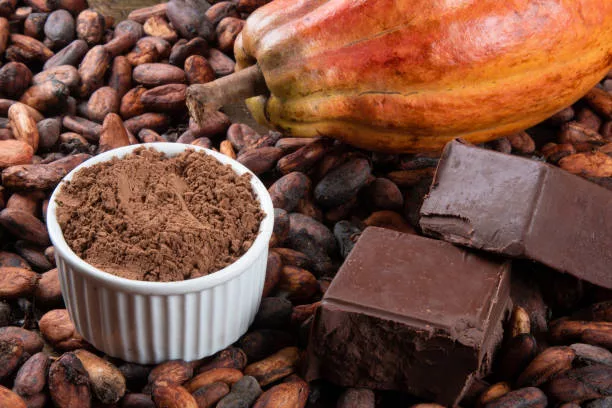
1. Chocolate Production:
One of the most common and delightful uses of cocoa beans is to make chocolate. Nigerian cocoa beans, with their unique flavor profile, are ideal for producing high-quality chocolate bars, truffles, and other chocolate confections. The beans are harvested, fermented, roasted, and ground to create cocoa liquor, which forms the basis of all chocolate products.
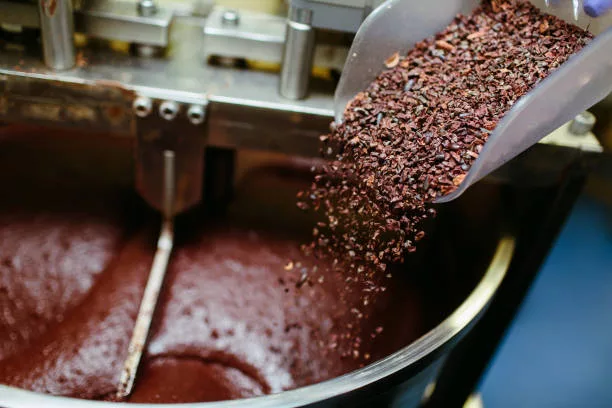
2. Hot Cocoa:
Nigerian cocoa beans can be used to make a rich and flavorful hot cocoa drink. To do this, grind the beans into cocoa powder and mix it with hot milk or water. You can add sugar or sweeteners to taste and enjoy a warm, comforting beverage.
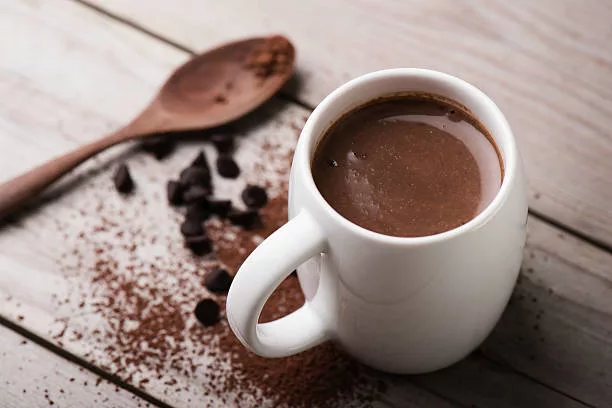
3. Baking:
Nigerian cocoa beans can enhance a wide range of baked goods, including cakes, brownies, cookies, and muffins. Cocoa powder made from these beans can be incorporated into the batter or used to dust the top for a delightful chocolatey flavor.

4. Chocolate Sauce:
You can use Nigerian cocoa beans to make a homemade chocolate sauce. Simply melt cocoa beans or cocoa powder with sugar and milk or cream to create a delectable topping for ice cream, pancakes, or desserts.
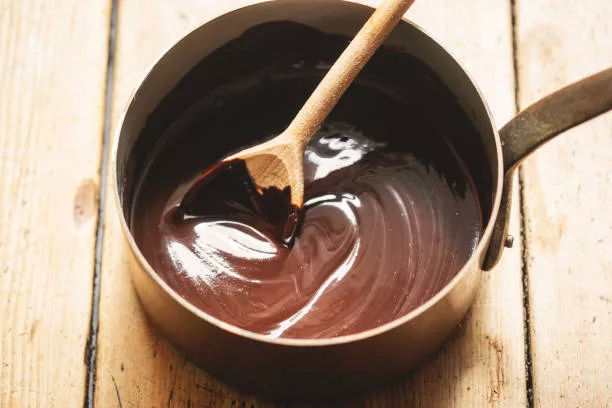
5. Smoothies:
Add a spoonful of cocoa powder made from Nigerian cocoa beans to your morning smoothie for a rich and chocolaty flavor. Combine it with fruits, yogurt, and a sweetener of your choice for a nutritious treat.

6. Chocolate Ice Cream:
For homemade chocolate ice cream, combine cocoa powder made from Nigerian cocoa beans with cream, milk, and sugar. Use an ice cream maker to churn the mixture into a creamy and indulgent dessert.

7. Chocolate Beverages:
Nigerian cocoa beans can be used to make a variety of chocolate beverages, from chocolate milkshakes to chocolate martinis. Experiment with different combinations to create your favorite cocoa-infused drinks.
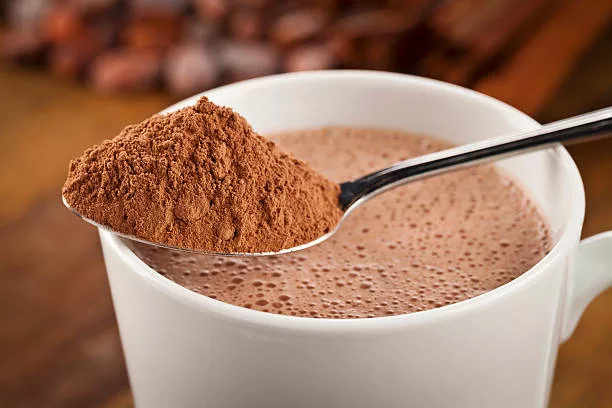
8. Truffles and Pralines:
Use cocoa liquor made from Nigerian cocoa beans as the base for crafting your own truffles and pralines. Coat your handmade confections in cocoa powder or melted chocolate for a professional finish.
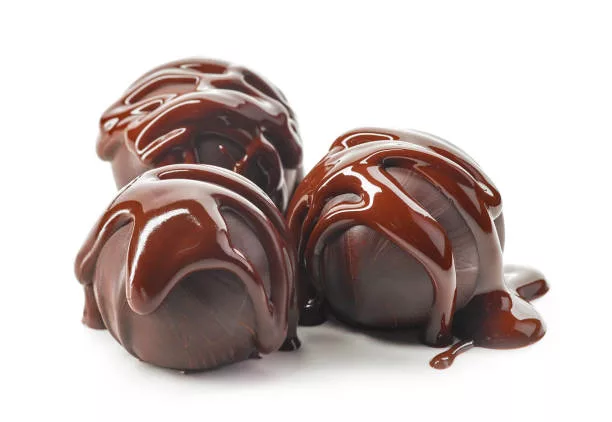
9. Cocoa Rubs and Marinades:
Create savory cocoa rubs and marinades for meats like pork and beef. The deep, complex flavors of Nigerian cocoa beans add a unique twist to your dishes.

10. Infused Liquor:
For a special treat, infuse your favorite spirits with cocoa beans. The result can be used to make cocktails with a delightful chocolate note.

11. Cocoa Tea:
Ground Nigerian cocoa beans can be brewed like tea to make a soothing and flavorful cocoa tea. You can enjoy it plain or add milk, honey, or other flavorings.

12. Beauty Products:
Cocoa beans are used in the production of skincare products. The natural antioxidants in cocoa are believed to have benefits for the skin. You can find cocoa butter, cocoa oil, and cocoa-infused cosmetics in the market.

Whether you’re indulging in sweet treats or experimenting with savory dishes, Nigerian cocoa beans can be a versatile and flavorful addition to your culinary and lifestyle choices. Remember to choose high-quality cocoa beans and products to fully appreciate their unique taste and aroma.
Recipes Using Nigerian Cocoa Beans
Here are a few recipes using Nigerian cocoa beans that you can try to enjoy the rich and unique flavors:
1. Nigerian Cocoa Hot Chocolate:
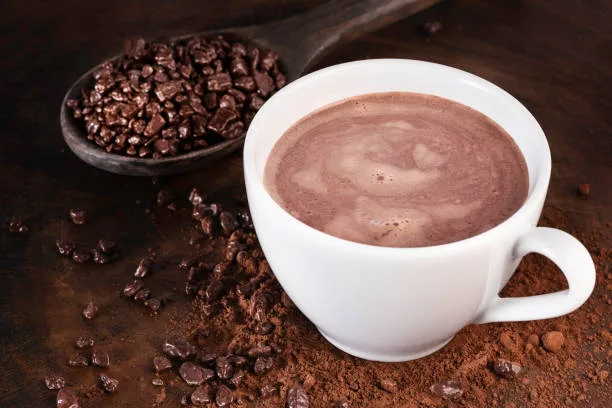
- Ingredients:
- 2 tablespoons of Nigerian cocoa powder
- 2 cups of milk (dairy or dairy-free)
- 2 tablespoons of sugar (adjust to taste)
- 1/2 teaspoon of vanilla extract
- Instructions:
- In a saucepan, heat the milk over medium heat until it’s hot but not boiling.
- Add the Nigerian cocoa powder and sugar to the hot milk. Whisk until the cocoa and sugar are fully dissolved.
- Stir in the vanilla extract.
- Pour the hot chocolate into mugs and top with whipped cream or marshmallows.
2. Homemade Dark Chocolate Bars:

- Ingredients:
- 1 cup of Nigerian cocoa liquor (cocoa mass)
- 1/2 cup of cocoa butter
- 1/4 cup of powdered sugar (adjust to taste)
- Optional: vanilla extract or sea salt for flavor
- Instructions:
- Melt the cocoa butter in a heatproof bowl over a pot of simmering water (double boiler).
- Once the cocoa butter is melted, stir in the Nigerian cocoa liquor.
- Gradually add the powdered sugar and any optional flavorings while stirring continuously.
- Pour the mixture into chocolate molds or a lined tray.
- Let it cool and harden in the refrigerator for a few hours or until set. Then, remove and enjoy your homemade dark chocolate bars.
3. Cocoa Rub for Grilled Steak:

- Ingredients:
- 2 tablespoons of Nigerian cocoa powder
- 1 tablespoon of brown sugar
- 1 teaspoon of smoked paprika
- 1/2 teaspoon of ground cumin
- Salt and pepper to taste
- 2 steaks (your choice of cut)
- Instructions:
- In a bowl, combine the Nigerian cocoa powder, brown sugar, smoked paprika, ground cumin, salt, and pepper to create the rub.
- Pat the steaks dry and coat them with the cocoa rub, pressing it onto the surface.
- Let the steaks sit with the rub for at least 30 minutes or longer in the refrigerator.
- Grill the steaks to your desired level of doneness.
- Rest the steaks for a few minutes, then slice and serve.
4. Cocoa Smoothie:

- Ingredients:
- 1 ripe banana
- 2 tablespoons of Nigerian cocoa powder
- 1 cup of milk (dairy or dairy-free)
- 1 tablespoon of honey or maple syrup (adjust to taste)
- 1/2 teaspoon of vanilla extract
- Ice cubes (optional)
- Instructions:
- Place all the ingredients in a blender.
- Blend until smooth and creamy.
- Add ice cubes if desired and blend again.
- Pour the cocoa smoothie into a glass and enjoy.
These recipes will allow you to savor the unique flavors of Nigerian cocoa beans in various forms, from rich hot chocolate to homemade dark chocolate and even a cocoa-infused steak rub. Experiment with these recipes to discover your favorite way to enjoy Nigerian cocoa beans.
Potential Side Effects and Things to Remember
When using and consuming Nigerian cocoa beans or cocoa-based products, it’s essential to be aware of potential side effects and some key considerations. Here are some things to remember:
1. Caffeine Content:
- Cocoa beans naturally contain caffeine, although in lower amounts than coffee. While some people enjoy the mild stimulation it provides, excessive consumption can lead to restlessness, insomnia, and increased heart rate. If you are sensitive to caffeine, be mindful of your cocoa intake, especially in the evening.
2. Allergies:
- Cocoa and chocolate products can be a source of allergies for some individuals. Symptoms may include skin rashes, digestive issues, or respiratory problems. If you have a known allergy to cocoa or related foods, consult with a healthcare professional before consuming cocoa-based products.
3. Sugar and Calories:
- Many cocoa-based products, such as chocolate bars and hot chocolate mixes, often contain added sugars and calories. Overindulgence can contribute to weight gain and other health concerns. Opt for dark chocolate with higher cocoa content and lower added sugar for a healthier option.
4. Quality Matters:
- The quality of cocoa-based products can vary significantly. Look for high-quality cocoa beans and chocolate products that use pure ingredients. Low-quality or overly processed cocoa products may not offer the same flavor or health benefits.
5. Moderation is Key:
- While cocoa does have some health benefits, including antioxidants, it should be enjoyed in moderation. As with most foods, balance is crucial to maintain a healthy diet and lifestyle.
6. Interactions with Medications:
- If you are taking medications or have specific health conditions, consult your healthcare provider. Cocoa may interact with certain medications, particularly those that affect blood pressure, heart rate, or mood.
7. Child Safety:
- Keep cocoa products away from young children and pets, as cocoa contains theobromine, which can be toxic in large quantities if ingested.
8. Skin Allergies:
- When using cocoa-based skincare products, be aware that some individuals may be sensitive to cocoa. Perform a patch test on a small area of your skin to ensure you don’t experience an adverse reaction.
9. Migraine Triggers:
- For some individuals, cocoa can trigger migraines. If you’re prone to migraines, monitor your cocoa consumption and be cautious when consuming cocoa-based products.
10. Personal Tolerance:
Everyone’s tolerance and sensitivity to cocoa can vary. Pay attention to how your body reacts to cocoa, and adjust your consumption accordingly.
Nigerian cocoa beans and cocoa-based products offer a delightful and versatile culinary experience, as well as potential health benefits. By being mindful of your consumption and considering the factors mentioned above, you can enjoy the unique flavors and attributes of cocoa while promoting your well-being. If you have specific health concerns or allergies, it’s advisable to consult with a healthcare professional for guidance on cocoa consumption.
Conclusion
Nigerian cocoa is a valuable and versatile ingredient with a unique flavor profile that’s distinct from cocoa produced in other regions. It plays a significant role in the country’s economy, offering employment opportunities to many.
The nutritional properties of Nigerian cocoa include essential minerals, antioxidants, and beneficial compounds like flavonoids. When consumed in moderation, it can contribute to various health benefits, such as improved heart health, mood enhancement, and cognitive benefits.
Cocoa from Nigeria possesses specific chemical properties like cocoa butter content, cocoa solids, flavonoids, theobromine, and more, which are essential for crafting delicious chocolate and cocoa-based products.
You can use Nigerian cocoa beans to make hot chocolate, homemade chocolate bars, cocoa rubs for savory dishes, and even cocoa-infused smoothies. The possibilities are diverse and delicious.
However, it’s important to remember that cocoa contains caffeine, and excessive consumption can lead to side effects like restlessness and insomnia. Some individuals may also have cocoa allergies, so be mindful of your tolerance. Additionally, be cautious about added sugars and calories in cocoa-based products and prioritize quality.
In the end, Nigerian cocoa offers a world of flavors and culinary possibilities. By enjoying it in moderation and considering individual sensitivities and preferences, you can savor its rich and unique attributes while promoting your well-being.
References
- [1]
Global Strategy for the Conservation and Use of Cacao Genetic Resources, as the Foundation for a Sustainable Cocoa Economy (B. Laliberté, Compiler)Bioversity International Montpellier France (2012), p. 186
- [2]
Genetic Diversity in Nigerian Cacao, Theobroma Cacao L. Collections as Revealed by Phenotypic and Simple Sequence Repeats MarkerPh.D. Thesis submitted to the University of Ibadan Nigeria (2007), p. 147
- [3]
Genetic identity and diversity of Nigerian cacao genebank collections verified by single nucleotide polymorphisms (SNPs): a guide to field genebank management and utilizationTree Genet. Genomes, 14 (32) (2018), 10.1007/s11295-018-1244-2
- [4]
ProfMahmut Caliskan (Ed.), Defining Genetic Diversity in the Chocolate Tree, Theobroma Cacao L. Grown in West and Central Africa, Genetic Diversity in Plants, 978-953-51-0185-7, InTech (2012)
- [5]
Cacao genetic resources conservation and utilization for sustainable production in Nigeria, Theobroma cacao-deploying science for sustainability of global cocoa economyIntech (2019), 10.5772/intechopen.82703
- [6]
Descriptive and discriminatory significance of pod phenotypic traits for diversity analysis of cocoa genotypesJ. Plant Breed. Genet., 1 (2013), pp. 131-137
- [7]
Breeding value of cocoa (theobroma cacao L.) for pod and bean traits: a consequential advance in Nigerian cocoa breeding programNot. Sci. Biol., 6 (2) (2014), pp. 214-219
- [8]
Comparative genetic diversity and nutritional quality variation among some important Southern African sorghum accessions [Sorghum bicolor (L.) Moench]Aust. J. Crop. Sci., 6 (1) (2012), pp. 56-64
- [9]
Factors influencing quality variation in cocoa (Theobroma cacao) bean flavour profile — a reviewFood Res. Int., 82 (2016), pp. 44-52
- [10]
Official Methods of Analysis(fifteenth ed.), Association of Official Analytical Chemists Washington DC (1990)
- [11]
SAS/STAT., Cary NC USA (2007)
- [12]
Food Analysis and Instrumentation: Theory and PracticeNaphthali Prints Lagos Nigeria (2005), p. 219
- [13]
Evaluation of the extent of genetic variability among Theobroma accessions using RAPD and RFLP markersTheor. Appl. Genet., 95 (1997), pp. 10-19
- [14]
Variation in agro-morphological characteristics of cacao, Theobroma cacao L. in farmers’ fields in NigeriaN. Z. J. Crop Hortic. Sci., 38 (2) (2010), pp. 157-170
- [15]
Biodiversity and nutrition: a common path toward global food security and sustainable developmentElsevier Journal of Food Composition and Analysis, 19 (2006), pp. 477-483
- [16]
Cocoa and coffeeM. Doyle, J. Beuchat, J. Wollgast, E. Anklam (Eds.), Polyphenols in Chocolate: Is There a Contribution to Human Health? Food Research International, vol. 33 (2001), pp. 449-4592000
- [17]
Cocoa: Chemistry of Processing(second ed.), Encyclopedia of Food Sciences and Nutrition (2003), pp. 1436-1448
- [18]
Chocolate Science and TechnologyWiley-Blackwell Publishers, Oxford UK (2010), pp. 3-82
- [19]
Changes in acidification, sugars and mineral composition of cocoa pulp during fermentation of pulp pre-conditioned cocoa (Theobroma cacao) beansInternational Food Research Journal, 20 (3) (2013), pp. 1215-1222
- [20]
The content of protein and non-protein (free and protein-bound) tryptophan in Theobroma cacao beansFood Chem., 124 (2011), pp. 93-96
- [21]
Production and quality evaluation of cocoa products (plain cocoa powder and chocolate)ISSN 2157-0167, Online: ISSN 2157-1317American Journal of food and Nutrition (2013), 10.5251/ajfn.2013.3.1.31.38.©.2013Science Huβ
- [22]
Proximate and Mineral Composition of Theobroma Cacao Bean and ShellAfribary.com (2018)
- [23]
Provitamin A carotenoid content of different cultivars of edible pandanus fruitJ. Food Compos. Anal., 16 (2003), pp. 237-247
- [24]
Carotenoid content of different edible pandanus fruit cultivars of the Republic of the Marshall IslandsJ. Food Compos. Anal., 19 (2006), pp. 484-494
- [25]
Content of alpha-, beta-carotene, and dietary fiber in 18 sweet potato varieties grown in HawaiiJ. Food Compos. Anal., 12 (1999), pp. 147-151
- [26]
Analysis of food composition data on rice from a plant genetic resources perspectiveFood Chem., 80 (2003), pp. 589-596
- [27]
Phenotypic and genetic correlations among floral traits in two species of ThalictrumJ. Hered., 92 (2001), pp. 361-366
- [28]
GGE Biplot Analysis: a Graphical Tool for Breeders, Geneticists and Agronomists(first ed.), CRC Press L.L.C., Boca Raton, Florida (2003), p. 271





